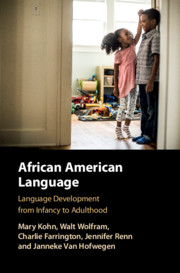Book contents
- African American Language
- African American Language
- Copyright page
- Contents
- Figures
- Tables
- Preface
- Abbreviations
- 1 Coming of Age in African American Language
- 2 The Analysis of Sociolinguistic Change over the Lifespan
- 3 Profiles of Change
- 4 Vowel Variation across Time and Space
- 5 Caretaker’s Influence on Vernacularity
- 6 The Influence of Peers on the Use of African American Language
- 7 Stylistic Variation in the Early AAL Lifespan
- 8 The Relationship of African American Language and Early Literacy Skills
- 9 A Longitudinal Study in Retrospect
- Appendix AAL Feature Code Key
- Index
- References
4 - Vowel Variation across Time and Space
Published online by Cambridge University Press: 24 November 2020
- African American Language
- African American Language
- Copyright page
- Contents
- Figures
- Tables
- Preface
- Abbreviations
- 1 Coming of Age in African American Language
- 2 The Analysis of Sociolinguistic Change over the Lifespan
- 3 Profiles of Change
- 4 Vowel Variation across Time and Space
- 5 Caretaker’s Influence on Vernacularity
- 6 The Influence of Peers on the Use of African American Language
- 7 Stylistic Variation in the Early AAL Lifespan
- 8 The Relationship of African American Language and Early Literacy Skills
- 9 A Longitudinal Study in Retrospect
- Appendix AAL Feature Code Key
- Index
- References
Summary
The analysis of vowel spaces for a subset of speakers in the Frank Porter Graham (FPG) study indicates that children and adolescents do not modify vowel pronunciations across the lifespan in the way that they alter morphosyntactic structures. Pockets of change (e.g., the price vowel), however, suggest that vowel variants potentially involved in community-wide change are more likely to be modified by children and adolescents, suggesting that children and adolescents do play a critical role in sound change. The analysis further reveals that the vowel patterns correlate strongly with school racial demographics, once again illustrating the formative role schools play in child and adolescent language. When considering lifespan change, different institutions impact the social experience of each age group. For example, the intensification of segregation that children experience within the school system differs from adults in the workforce. Within the United States, workplaces are more diverse and less segregated than school systems, suggesting that the combined forces of exposure with changing social identities lead to changing linguistic behavior. It appears, however, that such changes do not impact vowels in the same way they do morphosyntactic variables analyzed with the Dialect Density Measure (DDM).
Keywords
- Type
- Chapter
- Information
- African American LanguageLanguage development from Infancy to Adulthood, pp. 73 - 110Publisher: Cambridge University PressPrint publication year: 2020



